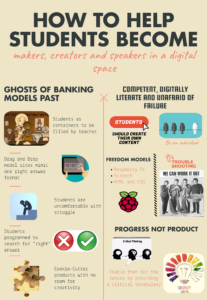
For my first multimedia reflection assignment I chose to read the Hinck article titled Digital Ghosts in the Modern Classroom. The author begins by stating that students today are fascinated with digital media and love to create it. However, most tend to use predominantly “drag and drop” models which recall the students as container education theories of the past. This method of education saw students as a tabula rasa (blank slate) which needed to be filled with the right answers which educators neatly provided to them. The process of education was seen to be linear with no room for deviation, student centered learning or creativity.
The author argues that these popular template/shortcut platforms mimic this archaic way of viewing students and education. These sites can be seen that way because they have predetermined settings with little to no room for students to make individual choices or display creativity. If, as educators, we encourage our students to create their own meaning and connections in the classroom, why should we not do the same when it comes to digital media?
In the article it is also pointed out that when students are asked to struggle through the process of working with HTML coding or CSS they often get frustrated and see any challenge as a personal failure. The old linear way of thinking still haunts students. They are uncomfortable with making mistakes and trying to fix them, they just want to achieve success (the “right” answer) and have a finished product.
I myself struggle with this phenomenon. My ineptitude with digital media and technology has, on more than one occasion, caused much anxiety and feelings of personal failure. In beginning to create my Piktochart infographic artifact I was nervous at just the thought of having to create my own content and share it in a digital space. I spent quite some time struggling to try to get everything to look just as I wanted. I had to look a few things up and ultimately learned a few tricks along the way (like how to mask pictures together to get different shapes). The process was uncomfortable but I kept Hinck’s article in mind throughout and kept on.
In moving towards a better future with our students, we have to learn from mistakes and try to employ digital media to teach them to create original content. Part of doing so is to show them that the road to success is filled with many mistakes and that working to fix these mistakes ensures progress. Students need to learn to value progress and problem solving over rushing to create a finished product. When they can achieve that, we can empower them to see themselves as valuable makers, creators and speakers in the digital world.
-Alyssa Poole
